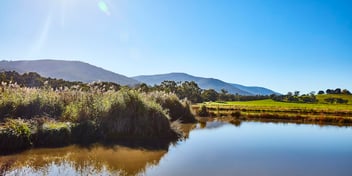Waterways mark Traditional Country areas
In a major step to formally acknowledge Traditional Country, the Victorian Aboriginal Heritage Council (VAHC) is set to reallocate boundaries between Traditional Owners of a largely disputed area of inner Melbourne.
Spanning 3721 sq km area, the negotiation area includes a variation boundary between existing registration boundaries of the Bunurong Land Council Aboriginal Council (BLCAC) and Wurundjeri Woi Wurrung Cultural Heritage Aboriginal Corporation (WWWCHAC).
Official speeches made in the negotiation area to date have acknowledged the overarching Kulin Nation rather than a specific group. However, consent to vary the boundary has now been given by the Bunurong and Wurundjeri peoples.
As Traditional Owners have a strong relationship to Country, influenced by its landscape and its catchments, the reallocated boundary has been drawn using rivers and other landmarks.
The direction of water flow indicates the shape of Country and reflects the cultural understanding of the Bunurong as ‘salt-water people’ and the Wurundjeri Woi Wurrung as the ‘people of the Birrarung’ (Yarra River).
Under this reallocation, the land north of Birrarung (Yarra River) will be seen as Traditional Country of the Wurundjeri People, while the area south of the river will be recognised as Traditional Country of Bunurong People.
In a statement made by the VAHC, the reallocated boundary will enable Traditional Owners to work together to care for Country.
“A line between our traditional areas, along a road or a current riverway, is an acknowledgement of our colonised environment. As the First Peoples’ of this place now known as Victoria, we must stand strong and protect Country through these imposed structures,” VAHC states.
“Working together, meeting and understanding the old ways, we can strengthen the places where we meet. In this way, our borders between mobs can be our strongest places, where we talk to each other, pass across songlines and hold ceremonies.
“It is Council’s responsibility and privilege to register Traditional Owner groups to care for their Country.
“Each decision Council makes, to register, to decline or to vary Traditional Owners’ recognised Country, is an enormous responsibility. We hope that future generations can benefit from the legacies we leave through our decision making.”
The BLCAC said the reallocation is a significant step for the Bunurong people.
“[It’s] a highly significant moment.. not just [for] the BLCAC, but for Bunurong People. We look forward to the determination taking effect and the work that lies ahead,” the BLCAC stated.
“Culture can sometimes be determined by the nature of the physical environment and the extent of Country is necessarily influenced by the landscape. What we read today is the dynamic of People living within the landscape.
“These Countries are based on catchments. Water that flows to the ocean and water that flows to the river. We can follow a catchment from its most easterly and westerly points, across ridgelines and around floodplains and sand belts.
“We think of standing and looking across Country, connecting the features and connecting the lines we can see with the Cultural lines we can feel.”

